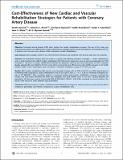Cost-Effectiveness of New Cardiac and Vascular Rehabilitation Strategies for Patients with Coronary Artery Disease

View/
Author
Spronk, Sandra
Bosch, Johanna L.
Ryjewski, Constance
Rosenblum, Judith
Kaandorp, Guido C.
White, John V.
Published Version
https://doi.org/10.1371/journal.pone.0003883Metadata
Show full item recordCitation
Spronk, Sandra, Johanna L. Bosch, Constance Ryjewski, Judith Rosenblum, Guido C. Kaandorp, John V. White, and M. G. Myriam Hunink. 2008. Cost-Effectiveness of New Cardiac and Vascular Rehabilitation Strategies for Patients with Coronary Artery Disease. PLoS ONE 3(12): e3883.Abstract
Objective: Peripheral arterial disease (PAD) often hinders the cardiac rehabilitation program. The aim of this study was evaluating the relative cost-effectiveness of new rehabilitation strategies which include the diagnosis and treatment of PAD in patients with coronary artery disease (CAD) undergoing cardiac rehabilitation. Data Sources: Best-available evidence was retrieved from literature and combined with primary data from 231 patients. Methods: We developed a Markov decision model to compare the following treatment strategies: 1. cardiac rehabilitation only; 2. ankle-brachial index (ABI) if cardiac rehabilitation fails followed by diagnostic work-up and revascularization for PAD if needed; 3. ABI prior to cardiac rehabilitation followed by diagnostic work-up and revascularization for PAD if needed. Quality-adjusted-life years (QALYs), life-time costs (US $), incremental cost-effectiveness ratios (ICER), and gain in net health benefits (NHB) in QALY equivalents were calculated. A threshold willingness-to-pay of $75 000 was used. Results: ABI if cardiac rehabilitation fails was the most favorable strategy with an ICER of $44 251 per QALY gained and an incremental NHB compared to cardiac rehabilitation only of 0.03 QALYs (95% CI: −0.17, 0.29) at a threshold willingness-to-pay of $75 000/QALY. After sensitivity analysis, a combined cardiac and vascular rehabilitation program increased the success rate and would dominate the other two strategies with total lifetime costs of $30 246 a quality-adjusted life expectancy of 3.84 years, and an incremental NHB of 0.06 QALYs (95%CI:−0.24, 0.46) compared to current practice. The results were robust for other different input parameters. Conclusion: ABI measurement if cardiac rehabilitation fails followed by a diagnostic work-up and revascularization for PAD if needed are potentially cost-effective compared to cardiac rehabilitation only.Other Sources
http://www.ncbi.nlm.nih.gov/pmc/articles/PMC2587698/pdf/Terms of Use
This article is made available under the terms and conditions applicable to Other Posted Material, as set forth at http://nrs.harvard.edu/urn-3:HUL.InstRepos:dash.current.terms-of-use#LAACitable link to this page
http://nrs.harvard.edu/urn-3:HUL.InstRepos:4540446
Collections
- SPH Scholarly Articles [6362]
Contact administrator regarding this item (to report mistakes or request changes)


